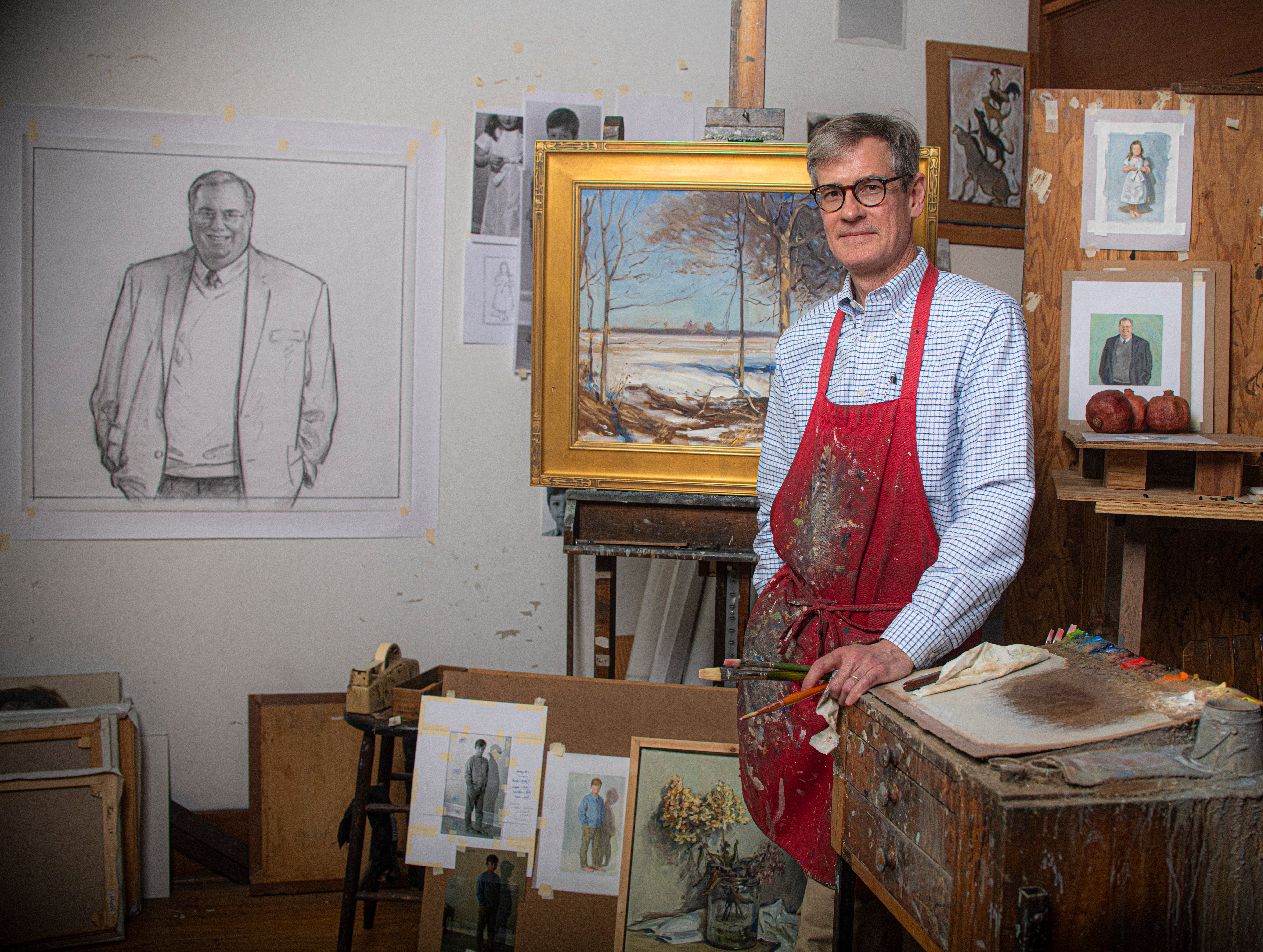By Julie Mabus
On a spring evening in 2012, Mississippi portraitist Jason Bouldin stood at a dais in Philadelphia, Pennsylvania. He was there to introduce his father, Marshall Bouldin, III, as the recipient of the 2012 Portrait Society of America’s Gold Medal. Eyes lowered, Jason began his comments. As he spoke of his talented father, Jason advanced his belief that the “great characteristic of a truly great artist, even more than talent, is being a fine individual and a good person.” He continued, “It is a wonderful thing that the Gold Medal is given to honor a recipient not only for his talent or his body of work but for the person himself, for that’s what animates all that we do as artists, animates everything that gets put down on canvas or gets carved into stone.” Jason turned to his father, “So Dad…,” and as he thanked his father, the tears began. The elder Mr. Bouldin, bowed by the weight of eighty-nine years, reached for his son, and they embraced; then Jason gingerly supported his father to the microphone. Four months later, Mr. Bouldin passed away.
The video of the event spoke more than words of praise. These were two incredibly fine men, humble despite their great artistic talents, who have animated their work with the measure of their own humanity.
And so, with the memory of that awards video, my interview with Jason Bouldin began.
Jason spends his weekdays in his remodeled studio in Oxford, next door to the home he shares with his wife Alicia and son William. Like his father’s work, Jason’s body of work is legendary.
Jason, the youngest of four successful sons, grew up in a nontraditional home on a working farm in Clarksdale, Mississippi. “Dad was brought up to be a good ole boy, but he knew there was something else for him.” Right out of high school in 1941, the elder Bouldin took a scholarship at the Art Institute of Chicago. He focused on art theory and intelligence above studio work and taught himself techniques by studying the great masters whose work hung in Chicago museums. When World War II commenced, Mr. Bouldin used his talents as an aircraft blueprint draftsman, eventually illustrating magazine covers in Westport, Connecticut. But something was still missing when he returned to Clarksdale in 1950. Jason marked his father’s turning point, “My father’s epiphany was a skull, a skull from my mom’s anatomy class.”
About Jason’s mother, Mary Ellen “Mel” Stribling Boulding, “Well, she was not a homemaker,” Jason smiled. “She went to the University of Tennessee and became an ob-gyn, piloting her Cessna back and forth to her work in Memphis. Mel Boulding was, indeed, another Mississippi Delta pioneer.
When Mr. Bouldin absorbed the beauty of the human anatomy through his study and sketches of the skeleton, he created an illustrated anthology, fully launching his brilliance and true love in portraiture.
Jason also went through his own epiphany…but it would be years in the making.
Jason was admitted into Harvard University his freshman year. But, he deferred admission and started his college education at Ole Miss. “I just don’t think I was ready to leave the state. It was the right decision in many ways. And I met my wife Alicia that year.”
Jason started Harvard the following year, majoring in art history. His father’s words resonated with him as he chose to spend countless free hours in the art museums in Boston and the surrounding cities of Springfield and Amhurst. “The point was to stick your nose in the art. There is such energy in the presence of a painting.” He continued, “A perfect photograph of great art still denies the depth, the texture…you must see the actual work right in front of you.” A sense of urgency strengthened his explanation.
I marveled at his self-awareness. “Portraiture is kind of an arranged marriage.” Of the four boys, Jason got the Bouldin art gene. Portraiture was his unspoken duty. But after several years of apprenticing under his father, his love affair with his God-given talent began to blossom.
“I understand now. Portraiture is about memory. A private commission provides that person’s history, his or her sense of place and belonging.” There was so much more behind his words. “When I see a portrait of my grandfather, I know I belong to that person.”
Of his public portraits, and the list is extensive, including Harvard academic and spiritual leaders, legislators, governors, and federal judges, Jason continued his musings about memory. “A portrait is just a mechanism, an easily accessible aid to memory. It allows me to be a historian, as the moon, shining a reflection of that person’s life. Gaining that perception is when I fell in love with my gift, when I understood my purpose.”
His musings intensified as Jason discussed the 2013 portraits of Medgar and Myrlie Evers. Through the leadership of the late Steve Edds, the Mississippi Museum of Art commissioned Jason to paint their portraits to commemorate the 50th anniversary of Medgar’s death in Jackson.
Evers was killed two years before Jason was born. “I grew up in a bubble in Clarksdale. When I was old enough to understand what had happened, racial violence had, seemingly, calmed down.” Jason paused, remembering, “Before I started the painting, I went to the Evers’ home; I had to get some sense of the man. The biggest thing I remember, he had come home for the evening and was at his back door. He was shot in the back, right there in his driveway. The shooter wouldn’t even look him in the face.”
Myrlie was only thirty years old when Medgar died at thirty-seven. Myrlie was still beautiful when Jason started the portraits, but she was different after fifty years of remembering, child-raising, and activism. Jason painted her as she was at the age of eighty, reflecting the years, the life experiences, and, finally, her peace.
Ole Miss Professor Marvin King agreed to work with Jason as a secondary source for Medgar’s physical form. With a light background and muted colors on a vertical canvas, Medgar stands at his prime, proud and strong as he was in life. Jason outlined his white dress shirt with whispers of vibrant colors, adding unexpected energy to the work. It is one of the many masterworks of this latter-day John Singer Sargent, signifying a time and place in our history.
On weekends, Jason retreats from his portraiture work to witness and put down on canvas the past life of forgotten or decaying plants and animals. In 2021 the Walter Anderson Museum paid homage to Jason and Walter Anderson with an exhibition “inspired by the artistic tradition of nature morte, or “dead nature.” Jason best states his intent, “I hope these works may not be viewed simply as studies, nor as any moral lesson; but rather as invitations to consider, to look with patience, to honor, to pay homage. These paintings were created without an audience in mind. They were made as very personal responses to the discarded objects and forgotten creatures which happened to come across my path – they are a tribute, a grieving, a wonder, an effort to be attentive, an attempt to offer testimony and evidence – to bear witness.”
I studied his face as he talked at length about the importance of recognizing and honoring the continued beauty of a plant or animal as it transitions on this earth from life to death. He spoke of the similarity between poetry and paintings–the vast meaning in and between a few words and the story that is discharged and laid out on canvas about a subject from just a few brush strokes.
Near the end of our meeting, Jason developed the imperative of two discreet likenesses in a painting. The composition must display the subject’s physical, tangible aspects in the world. But in the balance, the spirit of the subject must also be evident, must resonate with the soul of the individual without compromising the composition.
Jason spoke of this balance in a video about his “Bearing Witness” exhibition. “Walter Anderson was a genius about that…the marks that he makes around the subject are just as important as the marks he makes within the form itself. He paints this wonderful balance, this wonderful attention to the spirit of the subject and to the physical nature of the subject without sacrificing either one of them. And, man, I want to do that the same way.”
In finishing his story of bearing witness, he pointed to a painting of an aging magnolia wreath. The wreath he painted had hung on Jason’s father’s studio door during Mr. Bouldin’s funeral. Trying to follow his words, I scribbled something about Isaiah and ashes, not understanding but knowing it was important. I found it in Isaiah 61:3.
To grant those who mourn in Zion,
Giving them a garland instead of ashes,
The oil of gladness instead of mourning,
The cloak of praise instead of a disheartened spirit.
Thank you, Jason.








